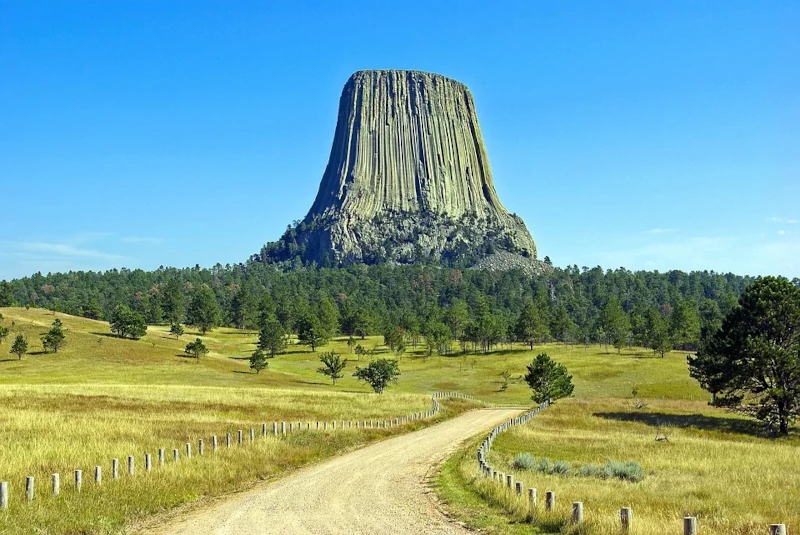Devils Tower Facts
- The most frequently used common name for this true marvel of geological forces is the highly attention-grabbing term of Devils Tower. Yet, it does have at least one other english language title. That’s the much less provocative moniker of Bear Lodge.
- The first recorded sighting of this marvel by an explorer occurred in 1875. At that time, Colonel Richard Irving Dodge spotted it during his expedition to explore the region. It’s considered likely, though, that others saw it earlier, but never recorded it.
- Local populations of Indigenous Peoples knew of its existence long before outside explorers ventured into the region, however. Though precisely how long remains unknown, archaeologists say centuries for certain, and possibly even for millenia.
- In the native tongues of various local populations, it holds differing designations. The name Bear Lodge is a translation from both the Cheyenne and Lakota. The original Cheyenne was Mato Tipila, while in Lakota it was the very similar Matȟó Thípila.
- The awesome Devils Tower holds a deep significance in the history of the native population of the region it sits in. Given that, and its natural splendor, it holds a special status that accords it a certain measure of protection against mans depredations.
- That’s due to the fact that, within the borders of the country in which it lies, the marvel represents a national monument. In fact, the Devils Tower National Monument became the very first such created. That historic event took place on September 24, 1906.
Related Articles
Devils Tower Physical Description
The geological wonder best known as Devils Tower never fails to awe and amaze those fortunate enough to view it. It’s also literally impossible to miss, standing out so prominently as it does from the surrounding terrain. It’s an utterly impressive structure.
The amazing tower’s highly unusual structure is characterized by its rather distinctive columnar appearance. Remarkably, this consists of vertically jointed columns with flat tops. These themselves also vary in width, and typically measure around six feet in diameter.
The surface of the tower further holds yet another marvel to bewilder the viewer. That’s because it’s also marked by numerous parallel cracks. Geologists believe these to be the result of cooling and contraction during its formation long ago. It also has a convex summit.
This massive formation has a composition that’s primarily igneous in nature. The main component appears to be a mineral named phonolie porphyry. It’s characterized by its fine-grained texture with large crystals embedded within a matrix of smaller crystals.
The awe-inspiring Devils Tower further impresses one with its sheer physical dimensions. From its base, it rises approximately 867 ft (264 m). That same base also has a circumference measuring roughly 1 mi (1.6 km). Meanwhile, its base diameter equals 600 ft (183 m).
Overall, its coloration adds to its visual appeal, offering a striking contrast against the backdrop of the surrounding landscape. Due to its mineral composition, its hues include various shades of brown, gray, reddish-brown, and, though less common, even black.
Devils Tower Location, Formation, and Ecology
The hauntingly beautiful Devils Tower formed in a part of the globe already well known for its abundance of geological wonders. That exact placement therefore won’t surprise may people. It formed in a portion of what’s now the continent of North America.
Lying inside the national borders of the United States, it further resides inside the state boundaries of Wyoming. There, in lies in the general northeastern section of the state. This places it in what’s known as the Black Hills region, near the Belle Fourche River.
This construct of Nature owes its formation due to volcanic processes, though not eruptive one’s. It formed due to the solidification of magma beneath the Earth’s surface. Around 50 million years ago, molten rock was forced upward into sedimentary rock layers.
Subsequently, the inevitable process of erosion came into play. Over the ensuing millenia, surrounding sedimentary rock gradually eroded away. This inexorable process eventually exposed even the more resistant igneous rock that formed the natural wonder.
While primarily known for its geological significance and cultural importance, This feature also hosts a diverse array of plant and animal life within its surrounding ecosystem. Surprisingly, to some individuals, this includes a wide variety of both plant and animal life.
Vegetation found on or around Devils Tower includes such varied types as grasslands, shrublands, and different types of forests. Common plant species include ponderosa pine, juniper, aspen, cottonwood, sagebrush, and various grasses and numerous wildflowers.
Mammals such as white-tailed deer, elk, pronghorn antelope, coyotes, bobcats, mountain lions, and various small mammals inhabit the area. Birdlife is also abundant, with species such as red-tailed hawks, turkey vultures, peregrine falcons, and numerous songbirds.
Reptiles and amphibians, including snakes, lizards, frogs, and toads, can also be found in the region. The area further supports a wide range of insects and invertebrates, including butterflies, bees, beetles, spiders, and various other arthropods. These play important roles.
Features Sharing Its Region
Check out our other articles on 4 Novel New Guinea Reptiles, Southern Elephant Seal, Lake Itasca, Mountain Ebony, Blue-winged Wasp, Eurasian Griffin Vulture, Rainbow Snake

